Newest progress reports are at the bottom of the page
I will try and update this page with new photos at least every 3-4 days. The date at the end of the caption is when the photo was uploaded. The actual progress of the layout is a little ahead of what you see here.
July 2013 - April 2016
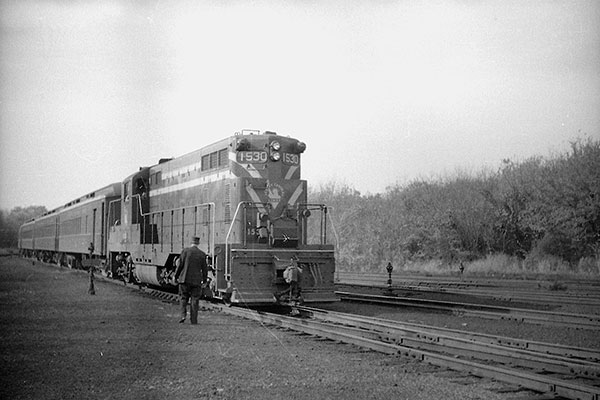
CNJ GP7 #1530 rolls into the coach storage tracks at Bay Head Junction in the mid 1950s. The diesels usually required little maintenance here other than a refueling and occasional water and sand for traction. (7/1/13)

CNJ GP7 #1520 rolls across the Shark River in Belmar at sunrise heading for Jersey City and the ferries across the Hudson River to Manhattan. The engine here is from Overland Models. Marriage and vacation has temporarily taken over my modeling time which is fine! (7/1/13)

I've been overloading my brain over the past few weeks trying to determine what my next move should be regarding the layout. I've been running some trains on the completed part but the present abrupt end of the double tracks at Asbury Park (off to the left, above) has left me dissatisfied since I have to manually turn the consists around there for the return trip. So I have pretty much decided to continue the mainline over the already-completed upper level bench work (above) and into a temporary 30 inch radius loop. Yikes! I promise this is only temporary!! (7/17/13)

From this angle the loop would occupy the basement bump-out over my supplies storage area. Construction would be of a temporary nature, probably suspended from the ceiling or a combo. I have been working on the mainline plans to South Amboy through the second half of the basement, but I can't move forward until certain planned renovations up above (kitchen) are started and completed, which might take a bit of time to do. I think the temp loop will keep me somewhat happy while I continue to scenic the first half of the layout. What does everyone think? (7/17/13)

Work has commenced on the remaining portion of the upper deck. Here I'm marking the centerline of the 36 inch curve. The foam risers will be used to elevate the tracks in this section, which models Allenhurst, creating an embankment along the right of way and allowing me to model an underpass as on the prototype. The entrance to Bay Head yard is below. (7/28/13)

The mainline crossed Deal Lake at Interlaken over a long fill and a short through girder bridge. I carved the fill out of foam and the girders are where the bridge will be. Asbury Park would be to the left and Allenhurst to the right. Water will occupy the plywood base. Next up is scratch-building the bridge concrete abutments and wing walls. (7/28/13)

The perimeter of the modeled Deal Lake has been sealed with caulk and the banks along both shorelines and the fill has received two layers of plaster. When dry, these banks will be sanded smooth. (7/30/13)

In the meantime, bridge construction continues. Unlike my other two bridges, this one is as simple as it can get with a wood base and girders glued on each side. The abutments are made from sheet styrene. (7/30/13)

The bridge abutments are finished and I've back-filled them with wadded paper towels covered with plaster. (8/2/13)

I also installed some of the Woodland Scenic foam risers to bring the roadbed up for an underpass and to model the prototype embankments along the right of way in this area. (8/2/13)

The NY&LB crossing over Deal Lake is completed for now. The next project is cutting in the Cedar Avenue underpass beyond the curve off to the right. (8/4/13)
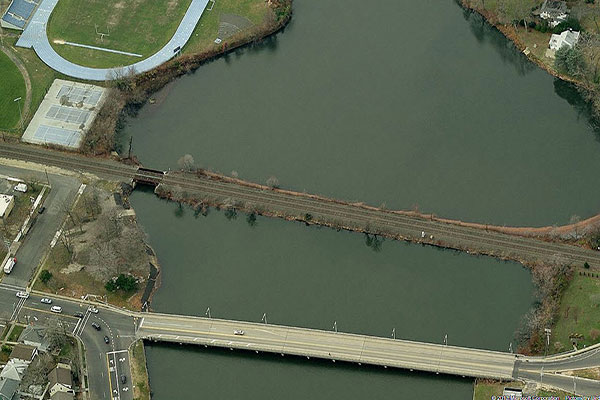
This is a modern day view of the North Jersey Coast Line fill and bridge across Deal Lake between Asbury Park (left) and Interlaken. The Main St. bridge is at the bottom of the photo. (8/4/13)

The Cedar Avenue underpass has been cut. This underpass dates back to the early 20th century if not earlier and is only wide enough for one lane of traffic. The roadway will be made of styrene and will dip under the tracks like the prototype. (8/6/13)

This is a present day view of the Cedar Avenue underpass. Main Street through Allenhurst runs along the bottom of the photo. The NJ Transit Allenhurst station parking lot is on the upper left. I decided not to model this station stop. (8/6/13)

Picked up a Chooch Industries flexible stone wall which will adorn both sides of the underpass. A siding paralleled this bridge to serve a coal dealer on the left side of the photo. After some consideration I decided not to model this siding that was pretty much done by the 50s. (8/12/13)

We drove up to Allenhurst last weekend to photograph the underpass. It's a simple bridge composed of just steel I-beams resting on concrete and stone abutments. The abandoned coal pockets are to the left with the truncated siding pier at the left center. (8/12/13)
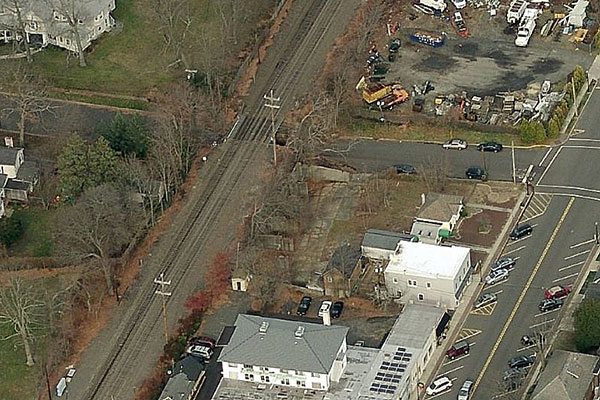
After some debating in my head I have decided to model the coal siding and trestle at Allenhurst after all. What remains of the coal pockets is seen in the center of the above photo. This facility was actually in operation into the early 1960s (surprise!) and I just can't resist modeling it. (8/20/13)

The Cedar Avenue underpass now has the roadbed raised to the prototypical 9 foot clearance and the bridge girders are in place. The turnout for the coal siding is in the background with additional risers and footings to follow. (8/20/13)

The Cedar Avenue underpass is mostly completed except for curbs and weathering of the roadway. The coal dealer will be to the left and will be built after the loop is in. (9/2/13)

The roadbed is done on the first half of the layout and after the tracks are laid I plan to tackle construction of the reversing loop as soon as possible. (9/2/13)

A mid-week day off and nothing to do except work on the layout! I cleaned off the alcove where the temporary reversing loop will reside. It turned out to be a pretty big job finding a home for all of the modeling stuff that resided there the past four years. (9/4/13)

I next dug through my scrap lumber and was able to cobble enough birch plywood together to construct the loop roadbed with 2x4 risers for support. The loop radius is approximately 28 inches. It's all screwed together since it's only temporary (I promise again!) (9/4/13)

When I begin construction of the second half of the layout the mainline will occupy the front part of this alcove, within reasonable reach over the PRR Atlantic Division staging yard below. The loop isn't pretty but it will do the job for now. (9/4/13)

This simple support at the end of the upper level holds the loop at a level even with the top of the cork roadbed. The track will be installed directly on the wood base with low cardboard sides to keep any mishaps from falling to the concrete below. (9/4/13)

Construction of the temporary loop continues. Here I have attached cardboard sides to keep any train mishaps from getting ugly. The front tangent (left) has hardboard sides to help stiffen the section over the yard below that has no supports. (9/9/13)

Here is a line up of most of my PRR K4s Pacifics on the upper level blob. These ten locos all have sound and smoke (4 MTH locos and 6 BLI Paragon 2 locos). My three older BLI sound locos and half dozen brass K4 models in various states are on the sideline for now awaiting upgrades. (9/9/13)

The temporary loop has been painted (for aesthetics) and the track installation has begun. The lack of insulated rail connectors potentially held things up until Tim Ferrie, owner of the Train Room in Point Pleasant Beach, came through with what I needed.. Thanks again Tim! (9/13/13)

Heavy 1950s era automobiles travel to and from Neptune and Avon on the wood overpass over the NY&LB. Once the loop is installed and the track work finished, the existing layout will get a long-awaited treatment of scenery, ballasting and signaling until phase 2 begins. (9/13/13)

The adhesive caulk is spread and awaiting the final section of cork roadbed on the first half of the layout. The completed return loop is in the background...propped up with a screwdriver until the cork is installed. Note the turnout pad for the FastTracks Allenhurst coal siding turnout. (9/16/13)

Here is the completed loop... ready and waiting. All that's left is installing the final three feet of double track, completing the buss wiring (4th district), building the Allenhurst Coal turnout control, and completing the coal trestle and bridge. (9/16/13)

After a few test runs with a non-sound simple diesel, a BLI K4s takes the inaugural run over the completed upper level heading for the new loop. (9/20/13)

The four car passenger train rounds the loop amid plenty of engine smoke. Love how these steamers from BLI smoke up the whole basement! (9/20/13)

The return trip heads over the small bridge between Allenhurst and Asbury Park. The test runs were all a success! (9/20/13)

Coasting into the Asbury Park Station, K4s #1139 glides over the Asbury Crossover. All that's left to install is the Allenhurst coal siding track then it's on to scenery. (9/20/13)
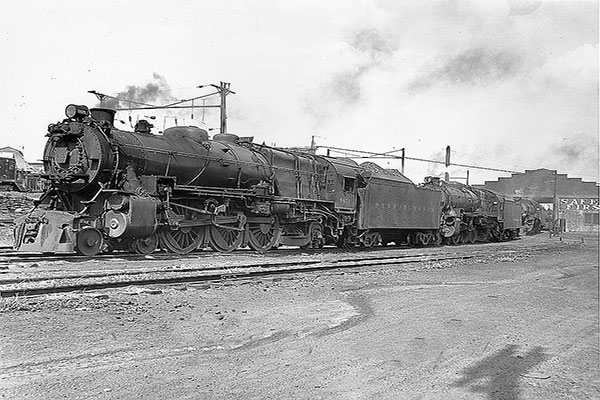
Vacation and renovations has kept me busy away from the basement...but in my head I'm moving full steam ahead. Above is typical South Amboy engine house and facilities during the 1950s. This location on the NY&LB will get the best modeling treatment possible on the second half. (10/3/13)
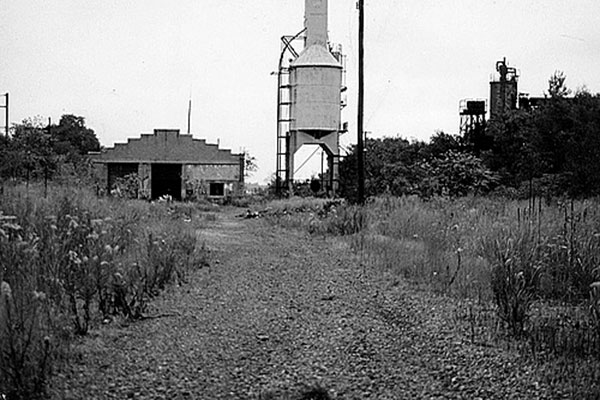
The same facility is seen here 45 years later in 1997. I hope to replicate it all....engine house, coal tower, ash conveyor, water tower and plugs, and whatever else I can fit in. Today everything in the above photo is gone except for some sections of track and piles of concrete rubble. (10/3/13)

I managed to squeeze in some layout time between all the painting upstairs this week. I roughed out the roadbed banks in foam with further smoothing to follow. A blue point turnout control and a mono frog juicer await installation. Track testing and tweaking also continues. (10/10/13)

The Allenhurst coal trestle is being kit-bashed from this PRR-type kit. The trestle will sit on concrete supports over the coal pockets. I now plan to scenic the upper level (including ballast) starting at this end...essentially working backwards from the previous layout construction. (10/10/13)

The embankments now have a treatment of plaster. The clothespin holds the actuator wire from the turnout control. Since the roadbed is pretty thick here, I had to go with a heavier and longer wire which works just fine. (10/13/13)

I'm modeling the 1950s, but this auto under the Cedar Avenue underpass, as well as ANY autos, didn't exist when the above coal siding was being constructed prior to 1900. I like how the Chooch flexible walls turned out here. (10/13/13)
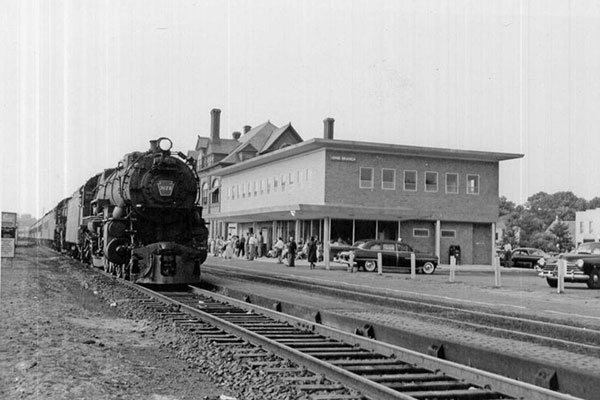
A PRR southbound (westbound) run pauses at the new Long Branch Station in 1955. The roof of the NY&LB Corporate building can be seen in the background. The jury is still out as to whether I'll be modeling Long Branch. Hope to if I can fit it in. (10/21/13)
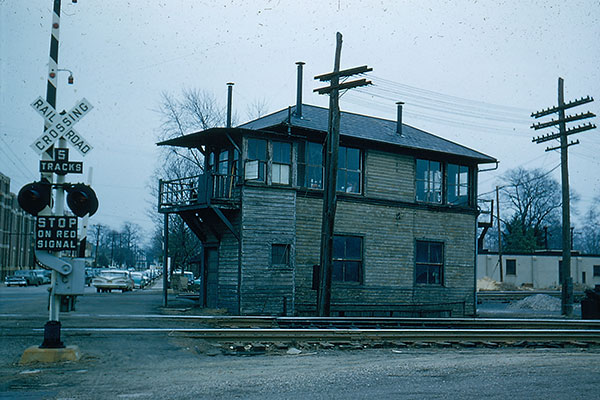
RB tower in Red Bank is seen here around 1960. The new crossing gates have been installed and the old watchman addition on the tower will soon be removed. Unfortunately, I haven't been doing much on the layout lately while painting my butt off in the rest of the house above. (10/21/13)
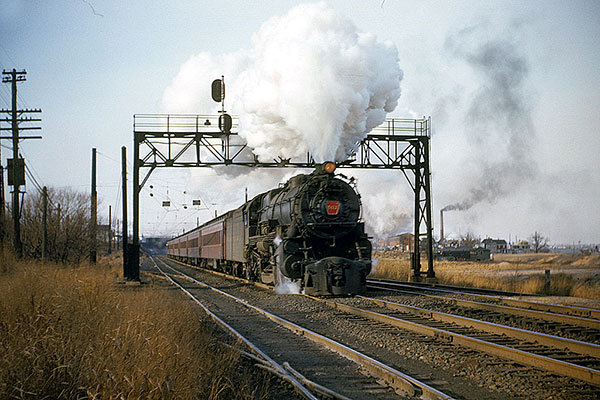
Been working on what color ballast to use for my NY&LB. The above photo at South Amboy in 1954 shows a dark gray over cinder. I'm pretty set on using Highball ballast and have several color samples on order. Promise the next update will have layout photos! (10/28/13)
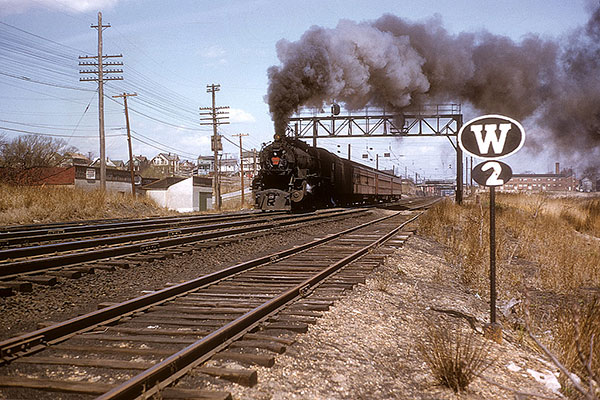
Another view at South Amboy in 1956. Love the classic CNJ whistle marker. I've been bouncing around what to do with the Allenhurst coal siding. The coal kit I mentioned isn't right and has been scratched. I am now planning to scratch-build the whole damn thing, I suppose. (10/28/13)

After a great weekend at the NJ Model Railroad Layout Design and Operations Event and layout tour of some fantastic modeling, I'm back in the basement and have installed the roadbed for the Allenhurst coal siding. As with all of my sidings and yards, the track transitions to a lower level compared to the mainline. (11/4/13)

This siding, from what I can ascertain, featured an I beam bridge over Cedar Avenue with a concrete abutment (right) and a support of about 6 feet of concrete and topped with steel H beams (left). I plan to restrict locomotives from crossing this bridge which will add a little challenge to moving hoppers in and out of the facility. (11/4/13)

Construction continues on the coal siding with the middle pier completed (but not painted yet- center). The coal pockets will follow while the local drill waits impatiently on the main line. (11/6/13)

Fast forward some 55 years and here is the real deal. The gates would be off the edge of the layout so unfortunately they won't be modeled, as well as all the modern underbrush. (11/6/13)

The Allenhurst coal unloading structure has been built. Notice the scribes in the styrene base. The poured concrete walls primary purpose was to support the track over the pockets. (11/13/13)

Extending beyond the concrete support/divider walls were heavy timber extensions shown here. They were recessed into the concrete dividers and supported by 12x12 posts. (11/13/13)

The coal facility has been weathered. I used India ink washes on the timber walls with grey and black chalk powders on the concrete. It's coal....it's dirty. (11/15/13)

This view of the trestle approach shows the future track supports. I placed an I beam on top which will extend through the facility under the tracks. Forming the coal piles is next. (11/15/13)
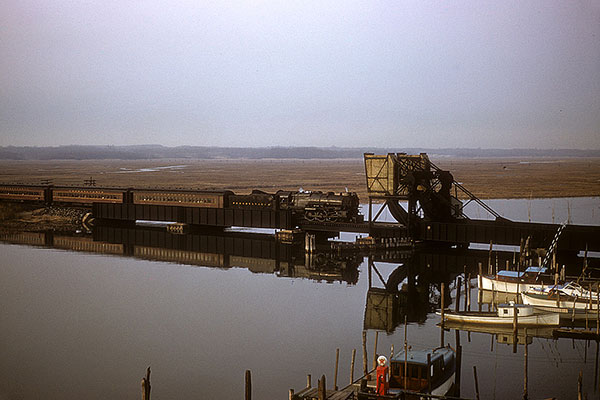
Happy Thanksgiving everyone! Needless to say...I've accomplished very little lately on the layout while feverishly completing the room painting in the house above. So in the interim, here is a great 1956 view of the rolling lift bridge at Morgan. (11/27/13)
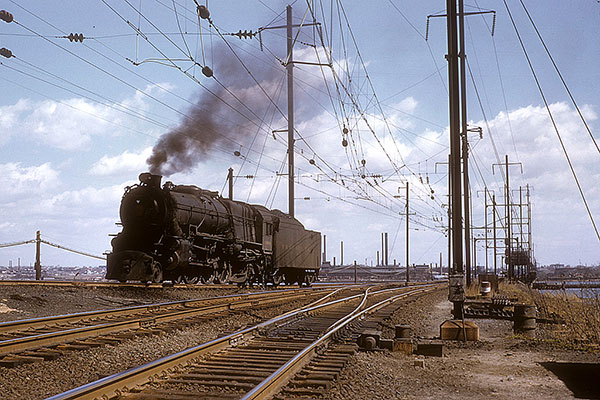
Another classic shot of a PRR k4s backing onto the mainline at South Amboy in 1956. Lately I've been contemplating maybe triple-decking the second half of the layout to fit in all of the scenes, such as these two, and do them justice without cramming. Just a thought. Any comments? (11/27/13)

Renovations and the holidays have kept me busy but I've managed to get a little work done recently. One inch foam is waiting to be carved into coal piles (right). (12/14/13)

Once I shaped the foam into what looked like mounds, I painted them black. The piles will be centered under the trestle when installed. (12/14/13)

The next step was to coat the piles with matte medium and then sprinkle scale coal over them. Extra coal will be added later after the mounds are placed in the coal pockets. (12/14/13)

In the meantime, I've been preparing this part of the layout for the scenery and ballast. This stretch is between Asbury Park and the temporary loop in the distance above. (12/14/13)
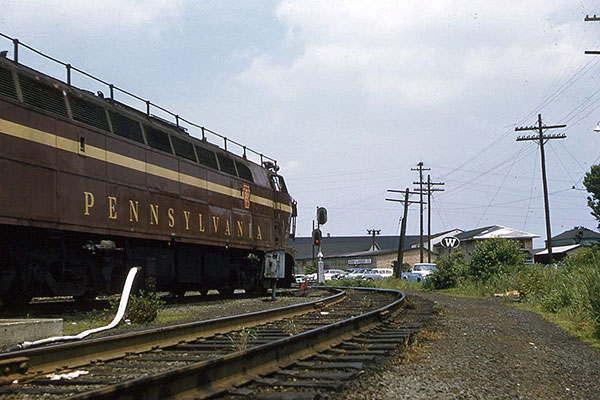
A PRR BP20 Shark diesel pulls out of the Bay Head Yard with a short commuter train in 1961. The old water column concrete base is on the extreme left followed by the white diesel water hose line. Bond Lumber Company (formerly Ferry Lumber) is in the background. (1/8/14)
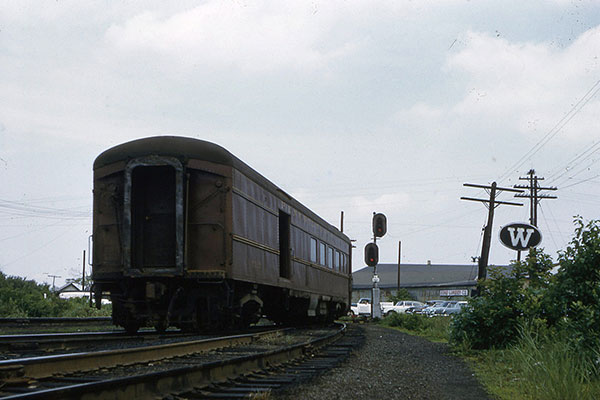
On the back end of the same train is a PRR combine! Meanwhile on the layout, I've been gathering scenery materials and formulating my plan of attack. I've also been working on minor track issues as I find them...nothing worth a photo update yet on these pages. (1/8/14)

This is the first section of the layout about to get scenery. The base is ready, the track ties have been painted and the track rails are painted. Just need to touch up the ties with a little grey dry brushing and build Grassmere Avenue and its rail crossing next. (1/16/14)

A totally improbable scene! A Norfolk Southern SD70ACe CNJ Heritage Diesel (MTH) pulling an old CNJ coach crosses the Shark River bridge at Belmar. I love bending my rules on occasion as many of you know by now. (1/16/14)

The Sunset Avenue crossing in North Asbury Park begins to take shape. Because the mainline sits a little above the surrounding landforms, I need to build the roads up using 1/16 inch styrene. The timber between the tracks are from Blair Line. (1/18/14)

The Grassmere Avenue crossing in Allenhurst needed a bit more of a ramp because the tracks here are rising on an incline. The timber crossings will be stained and the actual road surface will be built on top of the 4 inch wide styrene. Making the road banks is next. (1/18/14)

I'm using a fine grit wet/dry sandpaper for the road surfaces. I spray painted a large sheet above with dark grey primer which looks pretty good so far. (1/22/14)

The banks for Grassmere Avenue have been built and painted. The timber crossings have also been glued down here and at Sunset Avenue. (1/22/14)

Here is the nearly completed Sunset Avenue crossing. This crossing will get animated pneumatic gates operated by Logic Rail Tech Infra-red sensors. (1/23/14)

And here is the nearly completed Grassmere Avenue crossing. The painted sandpaper roadway turned out really well and is awaiting further weathering. Flashers will go here. (1/23/14)

After completing Sunset Avenue, I realized that the next crossing south, Asbury Avenue, would also need to be built because both crossings will be controlled with the same sensors. (1/24/14)

In the meantime, I filled in the gap between the two tracks with ordinary play sand which will be cemented into place. No sense filling them in with ballast that will never be seen. (1/24/14)

Track ballasting has begun on the layout! It's only a short section of track but I wanted to start small to get the technique down before getting ambitious. I'm ballasting the track between the rails first with a light/dark gray mix of Highball ballast. The shoulders will bet a base of cinders followed by ballast. Some areas will get trackside scenery before ballast. (1/26/14)

This is a shot of the NY&LB in Morgan in the mid 1950s showing the typical track ballast along the mainline. The darker areas are packed cinders. On the layout, spreading the ballast and keeping it off the ties and rails the best I can is followed by the standard alcohol spraying and dribble of Scenic Cement or diluted white glue. (1/26/14)

Progress continues with some more ballasting and working out the ABS signaling system. The signals for the first block are above. (2/4/14)

The NY&LB used mostly three over two block signals with three over three at interlockings and movable bridges and some other variations where needed. (2/4/14)

The majority of the NY&LB grade crossings were protected by manually operated gates. These Walthers gates at Asbury Park are prototypical and will be animated using sensors. (2/8/14)

After much searching, the cross bucks by Banta Model Works are real close to what was used on the NY&LB in the 1950s. Every crossing had these regardless of addl. gates and flashers. (2/8/14)

All of my animated grade crossings are planned to be controlled by the Infrared Grade Crossing Pro module by Logic Rail Tech. Where appropriate, a bell circuit will be added. (2/9/14)

The first pair of IR emitter and detector can be seen flush between the ties in the center of the photo. The Grassmere Avenue crossing is first in line with Tomar flashers and a bell. (2/9/14)
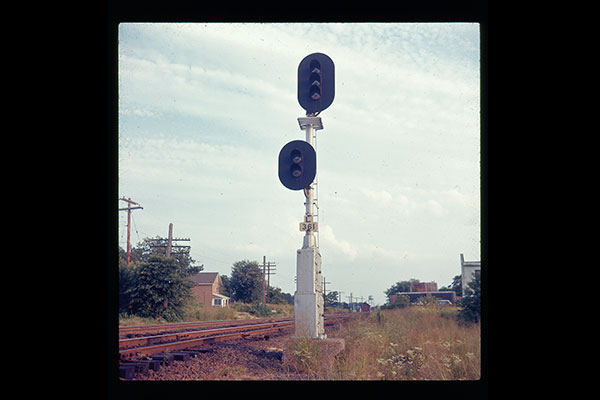
Here is block signal L361 on the southbound (westbound) tracks of the NY&LB in Point Pleasant Beach in the mid 1960s. Work continues on the layout at a slower pace while other house chores are taking up my free time lately. (2/19/14)
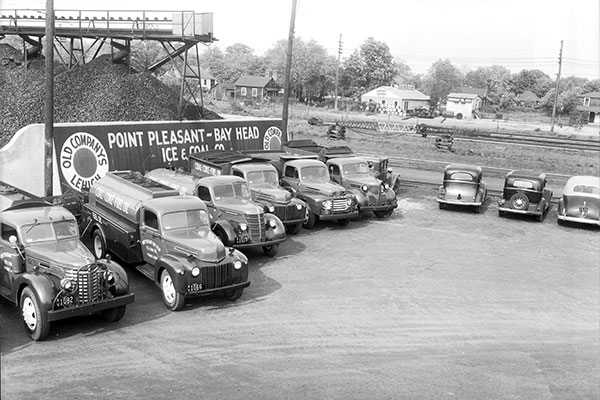
In Point Pleasant Beach, the Point Pleasant - Bay Head Ice & Coal Co. was a long-time rail customer. Note the large coal piles and overhead conveyor in this 1950 photo. Point - Bay Fuel now operates this site with oil storage tanks located where the coal was once kept. (2/19/14)
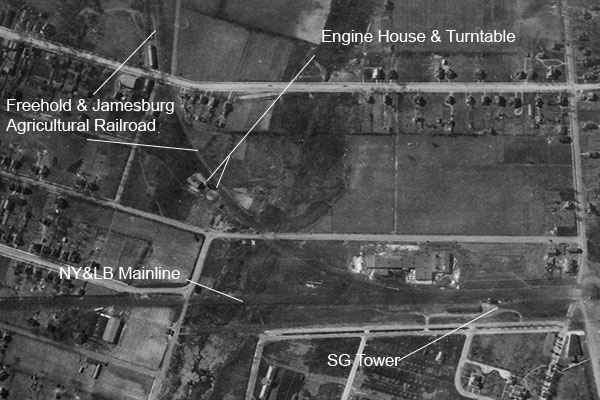
A bit of history.....This aerial view of the Sea Girt junction with the Freehold and Jamesburg was taken in 1920. Note that there was still a turntable and engine house servicing the PRR line. This facility most likely was built when the Jamesburg line was extended to Manasquan from Farmingdale in 1872 and eventually to Sea Girt station a couple of years later. (2/23/14)
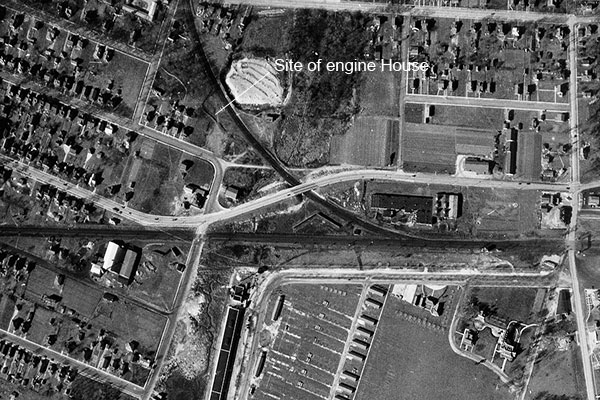
The Jamesburg line reached Sea Girt before the NY&LB did. This photo thirteen years later shows that the highway 71 overpass has been built (center) and a lot of land development has occurred. The PRR engine house and turntable are completely gone...no doubt the result of a facility that was no longer needed and the start of the railroad's cutting back. Interesting stuff! (2/23/14)
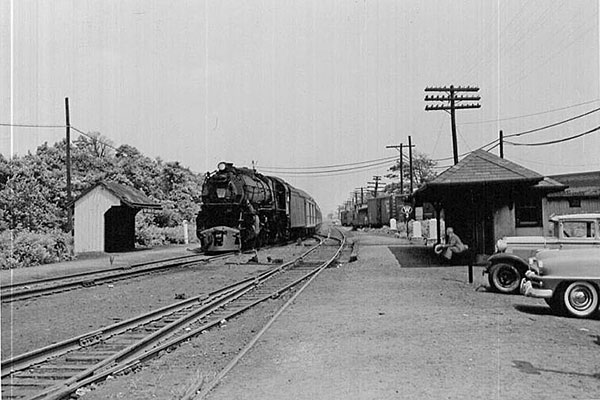
What can I say? A mountain of house chores has kept me out of the basement for the past month. Sorry everyone. In the meantime, here's a PRR K4s leading a southbound morning commuter run into Bay Head station and the loop in 1955. (3/18/14)
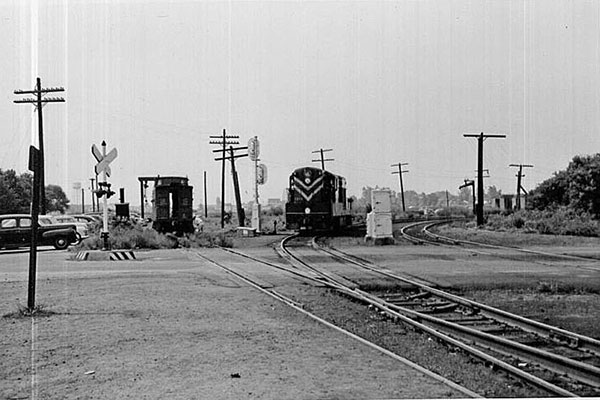
A CNJ Trainmaster leaves the engine tracks and will back into a string of morning commuter coaches at Bay Head Yard in 1955. I really have been working on some layout details and am waiting for parts to build my block detectors. More to come..... (3/18/13)
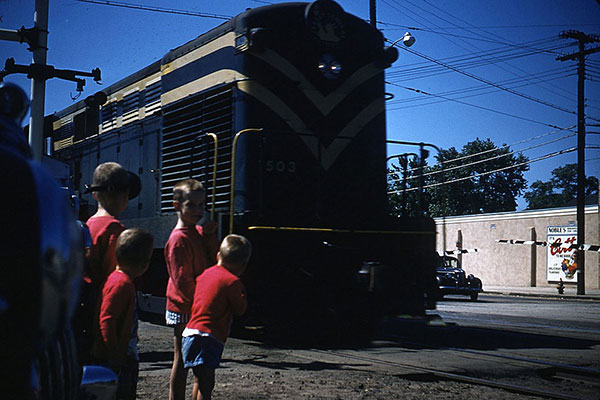
Sorry for the non-update everyone.....renovations continue on the 2+ story house sitting above the layout. But here's a great shot of a CNJ Baby Trainmaster closing in on the Point Pleasant Beach station in the 1950s. The kid's fascination is priceless! (4/5/14)
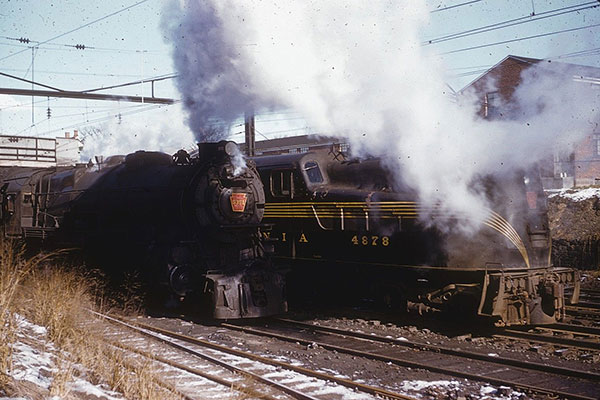
Also I'm STILL waiting for parts to build my signaling system! At the other end....a PRR k4s and GG1 await a swap of power in South Amboy in 1956. One more room to paint and I'll be back in the basement (I hope!) (4/5/14)

Well....housework has taken over my hobby life this spring, but, I'm still working on the layout when I can. I've decided on a simple block detection circuit for the layout and the parts for such (they finally came) are above (single block). Hope to be back soon! (5/22/14)
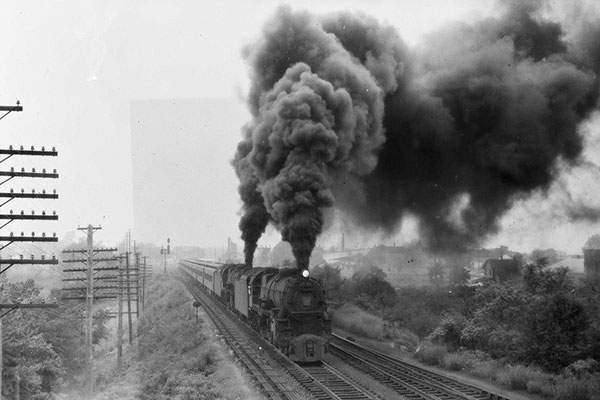
In the meantime, here is a great shot of a PRR double-header commuter run leaving Matawan station heading for Bay Head Junction in 1955. This photo was taken from Matawan Tower looking generally north (railroad East). (5/22/14)

Yes I'm still around! Ten years of home renovations crammed into one is bad for modeling. Here is a NS Pennsylvania RR Heritage (Bachmann) diesel squeezing through the Manasquan River draw. Another fantasy scenario. Couldn't resist the Norfolk Southern Heritage units for my two roads (see the CNJ unit farther above). Layout building will resume by Labor Day at the latest. (7/10/14)

I recently purchased a couple of Bachmann Silver Series P70 coaches. These are the new and improved ones, not to be confused with the old series they put out back in the 90s I think. I have many of the old coaches and got these to see what the improvements are and to hopefully apply them to my old ones. These are really nice and look pretty accurate. (7/20/14)

I've been returning to the basement over the past week specifically to start running test trains looking for track issues. A serious one involved my two reversing loops at Bay Head Yard and the temporary loop. The MRC reversing modules I was using were giving me erratic shutdowns so I have replaced them both with Digitrax AR1 modules with excellent results. (8/31/14)

Unlike the MRC units, the AR1 modules have an adjustable current trip which I believe is what did the trick. A Broadway Limited PRR K4s, above, rounds the temp loop without a hiccup. The Bay Head loop at the other end has also been fixed. I'm running these steam locos over the entire layout forward and reverse detecting track defects. (8/31/14)

This couple found the Shark River Inlet a bit too much for their small sail boat so they are heading in and now waiting for the NY&LB Shark Draw to open for their puny craft. The first official open house of my layout will happen on Sunday October 26 in conjunction with the New Jersey Layout Design/Operations SIG and RPM Meet on the 25th and 26th. Check it out here. (9/16/14)

With no scheduled train traffic the rolling bascule has opened. Meanwhile the Route 35 Highway bascule bridge has lowered the gates and is about to open as well. An all-too-well typical scene at the Jersey Shore. Anyone who wishes to stop by and check out my layout can do so by emailing me and I will give directions. The layout will be open from 9-2 Sunday the 26th. (9/16/14)
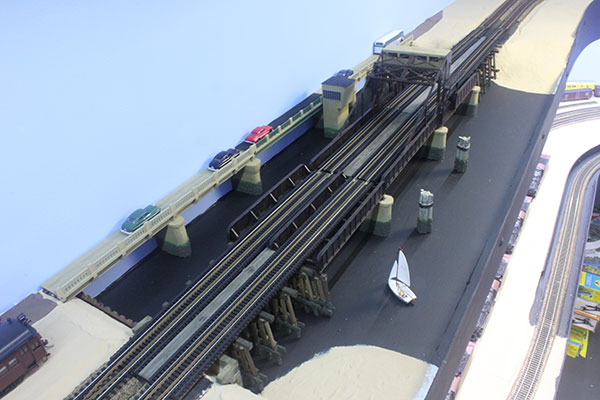
With an open house looming, I decided to finish detailing some scenes on the layout. The Shark River bridge here got inter-track planking and the approach details were completed. Besides the water and shores, the interlocking shack and bridge fenders are still on the to-do list. (9/25/14)

I also turned my attention to the Allenhurst coal facility. The coal bins are done and the trestle and track are completed. Still need to do a bit of weathering and build a track bumper. I also installed the first real permanent scenery on the layout, green vines on the block walls (right). (9/25/14)

Work continues on detailing the two bridges and coal facility on the layout. Here, inter-track planking is completed on the wood trestle over Will's Hole in Point Pleasant Beach. (10/11/14)

At the Shark River, side walkways and steel railings are going in. After watching some old footage, I realized that these existed in the 50s and add a lot to the bridge. (10/11/14)

I recently acquired a BLI address programmer to do some quick programming of all my DCC equipped locos. It will check the address as well as program. Except for my MTH locos, it worked like a charm and I'm happy I invested in it. Before the layout tour I powered much of my engines and filled the basement with coal-smoke and sounds from a dozen steamers and diesels. (10/27/14)

The layout tour on the 26th was a great day! Thanks to everyone (30+) who stopped by and shared their thoughts and enthusiasm about the layout! I now know that I am indeed on the right track for a prototypically operated layout with a mix of passenger and freight traffic. The whole day was a blast! I'm now aiming for the first "shakedown" and setting up operations. (10/27/14)

While waiting for the arrival of some long-shank drill bits, I have been doing a bit more ballasting. Above, I had to spread white glue on the embankment to help secure the cinders to follow. Most of the embankment here will be covered with underbrush later. (11/6/14)

To help keep the loose cinders from falling all over everything, I built a quick and dirty dam out of masking tape before spreading the ballast. After the cement dries, the tape will be removed. The mainline above will be ballasted after the drill bits arrive and signal sensors are installed. (11/6/14)

All sixteen of the Grassmere Avenue grade crossing sensors have been installed (that's 4 pairs of sensors per double track) and the Grade Crossing Pro boards and crossing bell board have been mounted (above). Wiring it up is next while ballasting continues in this part of the layout. (11/24/14)
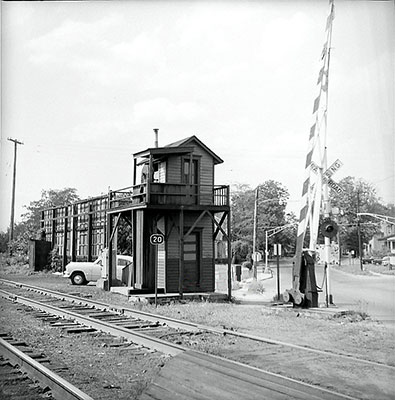
This was the Shrewsbury Avenue crossing in Red Bank in 1965 shortly before it was upgraded. The CNJ elevated crossing shanty is a classic, as well as the 20mph speed sign and the pneumatic gates. Not-so-typical is the single-target flasher. This view is to the north. (11/24/14)

Track ballasting is almost complete between the Grassmere Avenue crossing and the temporary loop. I've been ballasting the shoulders with cinders first followed by ballast....then finishing up between the rails. I use a plastic spoon to spread the ballast, followed by spreading it with the wide brush, and then smoothing and shaping it with the foam brush (above). (12/12/14)

Above is an overall view of the 7 foot upper level that is getting around 80% finished first. Once this section is done then I plan to start ballasting work on the lower level underneath which contains the Bay Head Loop. Ballasting of the upper level will continue as well off to the left along with signal work and grade crossing wiring into Asbury Park. (12/12/14)
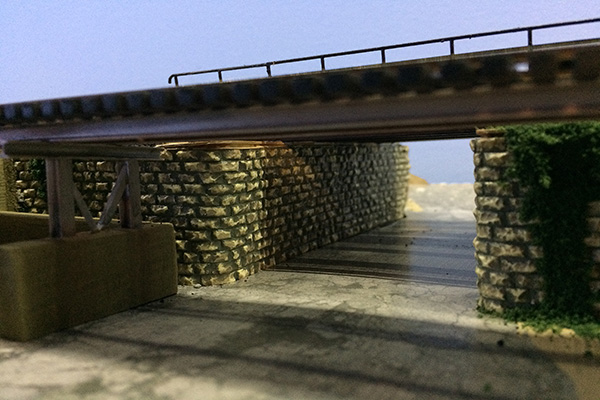
The holidays and furniture painting slowed me down a bit but work is progressing on the signal wiring and ballasting. Above is the Cedar Avenue underpass with the coal trestle in the foreground. Additional scenery here is forthcoming. (1/19/15)
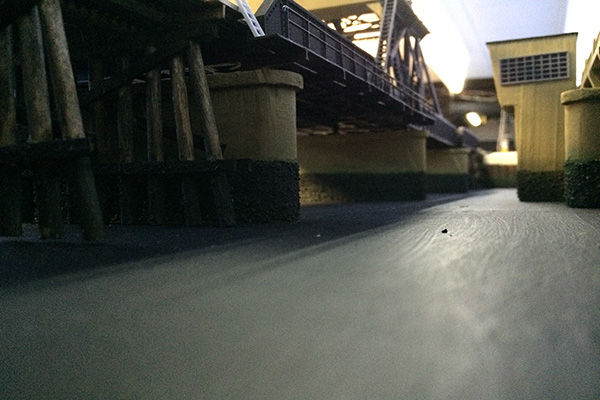
On the other side of the layout, here is a view of the backside of the Shark River bridge. The highway bridge is on the right. After I pour the water for Deal Lake, this river will be next. Should be quite a challenge! (1/19/15)
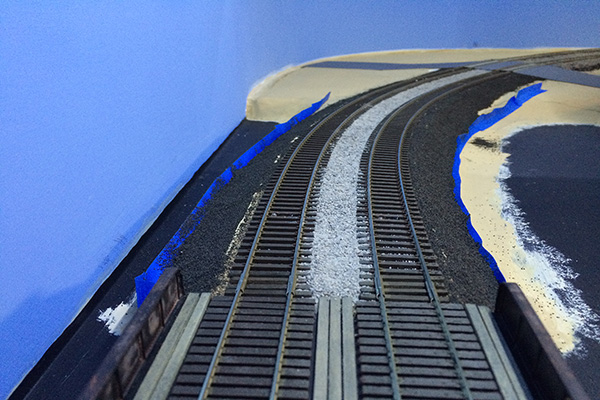
Ballasting the track with a base of cinders. The blue masking tape dams help keep the cinders from going all over the place on these steep embankments. (2/4/15)
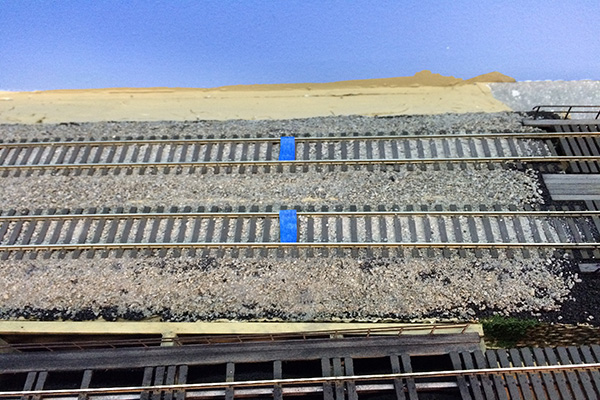
I also used the blue masking tape to cover the infrared sensors between the rails while spraying alcohol and dribbling scenic cement. (2/4/15)
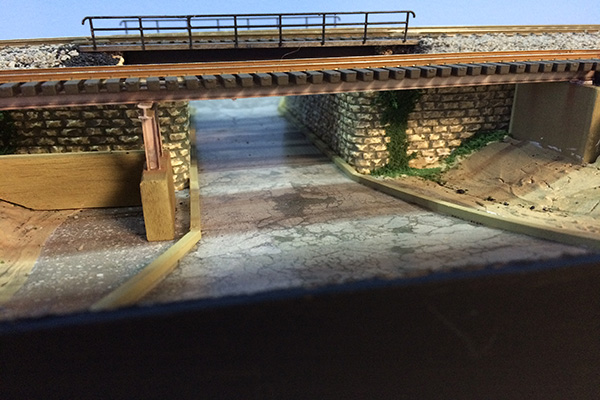
I was in the mood to take on more scenery work and installed the concrete curbing at the Cedar Avenue underpass using some .087 square basswood painted with aged concrete. Various ground foams will fill in both outer sides of the curbing as there were no sidewalks here. (2/8/15)
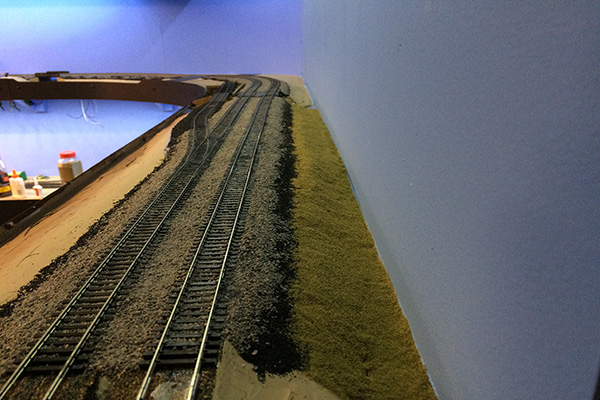
The first real ground cover has been put down along the rear embankment at Allenhurst. I figured it was safe to start here since this area is not very visible to operators and guests. The pole line, underbrush and some trees will follow along here. Used WS earth blend ground foam. (2/8/15)
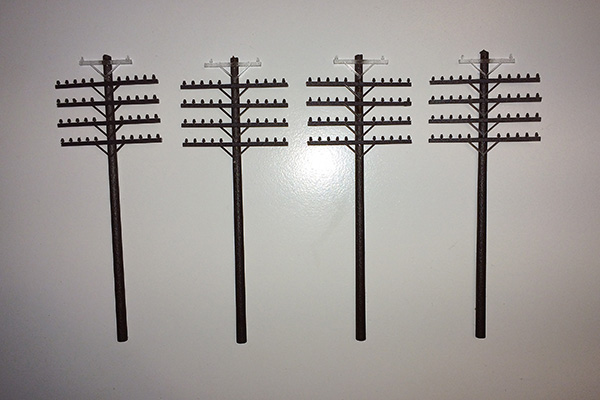
It's been a bit chilly in my basement the past month so progress has again slowed a bit. Back upstairs though I've been assembling signal poles using Rix kits. The poles will vary from grey to brown when painted. The insulators will vary between clear, brown and green. (3/4/15)
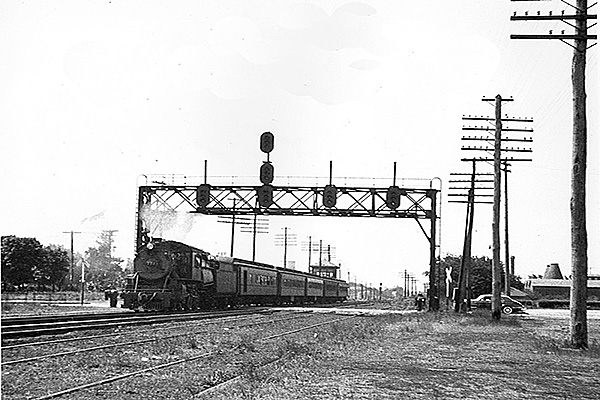
CNJ #777 heads eastbound through Sea Girt at Washington Avenue. This location was the only spot on the entire line that the pole line crossed over the main. The small cross-arms at the top of the poles carried high voltage. Some sections of the NY&LB didn't require this feature. (3/4/15)
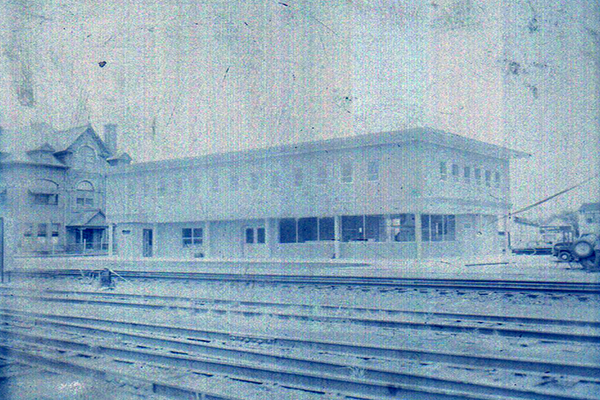
I've been picking up the pace somewhat again on the layout while still planning the second half. This is a rare view of the second Long Branch station under construction in 1955. The NY&LB offices are on the left while the original station if off to the right. Layout plans are forthcoming! (5/1/15)

A PRR commuter run heads eastbound out of Interlaken toward Long Branch on the layout. Pole construction and scenery details continue as time permits. The poles still need painting and lines, not to mention trees and brush around them. So much to do and so little time right now. (5/1/15)

An Atlas CNJ TrainMaster scoots up the helix during recent track testing and adjustments. I'm still hammering out the details for the second half of the layout as I want the whole thing depicted in the track plans when I post them here soon. (6/21/15)

A PRR Brill Gas-Electric #4666 passes over the Shark River bridge heading toward Sea Girt and the junction with the Freehold & Jamesburg to Trenton. Other minor work on the layout continues between extensive home renovations both inside and outside. (6/21/15)
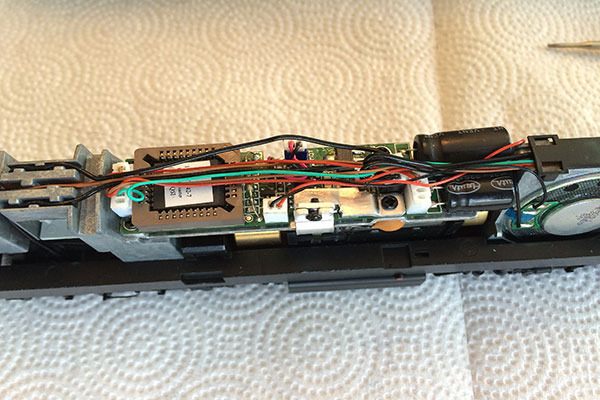
With track testing continuing, I decided to start equipping some of my locos with a keep-alive capacitor to help with the rough spots that are inevitable on most any layout. The Atlas TrainMaster above was the first candidate. The OEM QSI sound decoder is shown here with the loco shell removed. I next unplugged the wires from the board, removed the decoder and traced the DCC input power. (6/23/15)
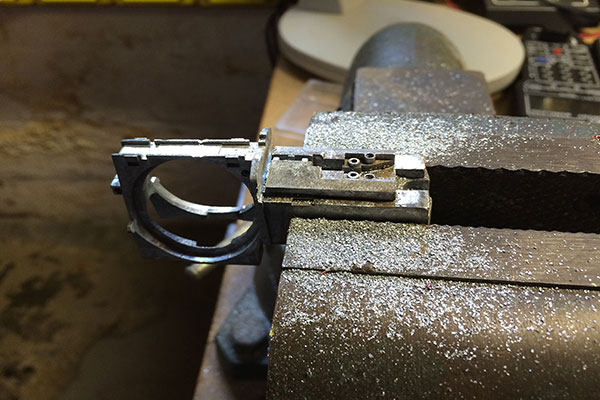
I used a TCS KA2 super cap array in this loco. Finding where to connect the positive and negative capacitor wires to the decoder was easy. They are soldered to the DC side of the bridge rectifier on the circuit board. However, there wasn't enough clearance for the KA2 without modifying the chassis....the cast metal speaker assembly shown here removed from the frame. (6/23/15)
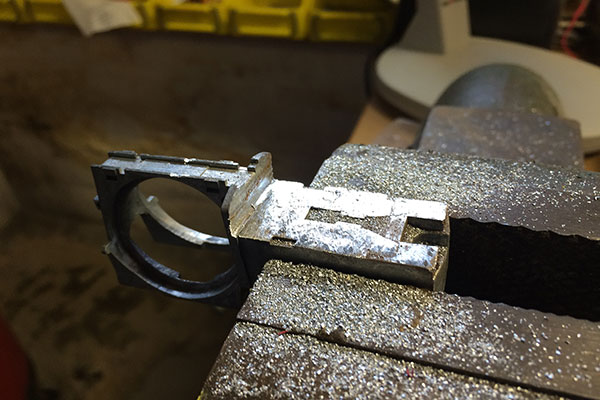
I cut off the protruding metal section that wasn't being used in this loco and filed it smooth. Then I thoroughly washed and dried the piece to remove the metal shavings. This provided enough clearance for the capacitor under the plastic loco shell. (6/23/15)
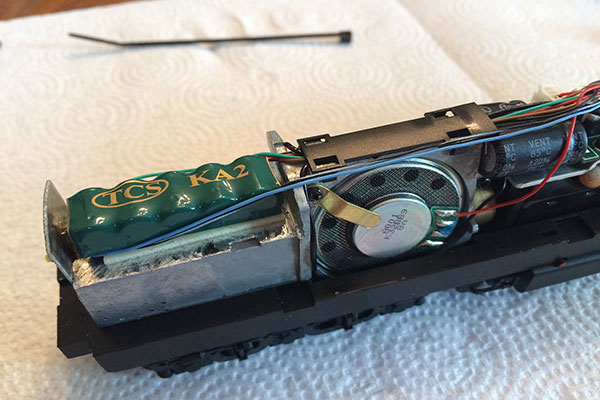
Here is the end result. I needed to remove the double sided tape shown here and replace it with a dab of silicone for more room. The loco runs great and keeps going with sound for over 12 seconds without track power. A K4s steam loco will be next to get a KA2. (6/23/15)
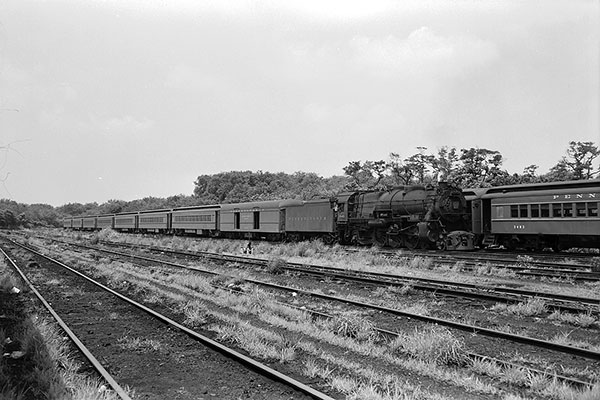
PRR K4s 5471 and her seven coaches/one baggage car eases into the Bay Head Yard coach storage tracks in the mid 1950s. Note the unkempt condition of the yard. (a modeler's dream/nightmare) Well, I've been busy elsewhere this summer with work, vacations and house renovations keeping the layout mostly dormant. I have about a dozen different modeling projects ongoing on the layout and hope to narrow those down by half to keep things manageable. (8/23/15)
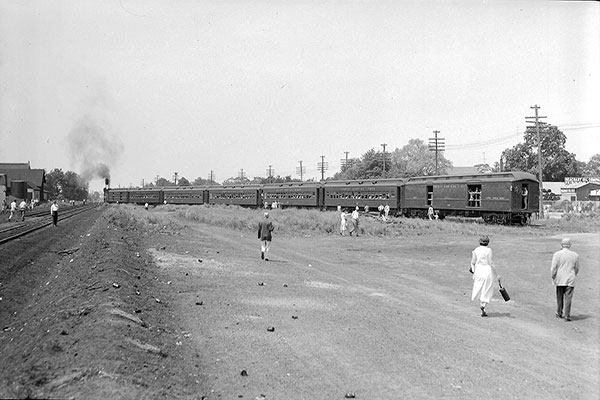
The NRHS special CNJ Camelback excursion train departs eastbound from the sidings at Point Pleasant Beach on July 11, 1954. The view is north with the PPB station off to the left. This land today is the municipal parking lot for the present station. Back to the layout....I am about to resume my modeling of the NY&LB shortly. Track plans are coming along and the second half of the basement is expected to be cleared this fall for future construction. (8/23/15)

Yes it looks ugly but this is a test run of a BLI Paragon 3 PRR K4s steam loco with a newly installed TCS Keep Alive in the tender. Everything will be packaged up right after the testing. This beast draws a good amount of power! The loco ran for less than 5 seconds before draining the TCS device, but that's more than enough for me. Since I do all of my programming on the main, the Keep Alives don't interfere with decoder programming... so far. (8/27/15)

The other half of the basement is about to be dismantled for the next construction phase. Red Bank and the junction with the CNJ Southern will be on the upper level where the work bench is (left). Matawan will be on the right past the slop sink over the helix to the lower level. I'm planning South Amboy where the two white tables are, followed by the Raritan River and into staging under Red Bank above. All of the workbenches are heading for the garage. Can't wait! (8/27/15)

Hi everyone! It's been a long 7 months since the last update. Seven months of, out of necessity, placing the layout on hold while the home renovations needed to be completed. This took up almost all of my spare time. Happily, they have been completed this week and I have begun work on the layout again. Above is the Manasquan draw looking north in 1968. (3/25/16)

The house renovations had a direct tie-in with what went on below concerning the second half of the layout. This effectively put a halt to progress until now. Instead of posting stuff about things not related to the layout, I decided to mothball everything until the work was completed. The first order of business is to get things ready for an open house in May. South Amboy above. (3/25/16)

While running test trains over the layout, I discovered a few problems. Above shows a major dent on the main in Bay Head Yard. Have no idea how that happened! I also programmed all of my NCE DB1 circuit breakers to handle sound and the two reversing loops without cutting out and killing the engines. Thant's an old problem finally solved. (4/2/16)

Here is a typical example of a trouble spot only running trains can detect. The track at the top of the helix had a small dip on one track that caused intermittent derailings. A shim did the trick here. I also found a few short sections of track in complex trackage that were dead. A couple of turnouts are being a nuisance and are next to be scrutinized. (4/2/16)

The Manasquan rolling lift bridge opens for boat traffic in the Manasquan River. I use the MRC Wireless DCC on my layout. I found that the AAA rechargeable batteries that come with the handhelds aren't the greatest at holding a charge. I have replaced all of the batteries in my four wireless handhelds with Duracell rechargeable cells. What a difference! No more dead handhelds after a few weeks of inactivity. (4/5/16)

An assortment of freight cars populate Neptune Yard waiting to be off-loaded or to be picked up by the local turn. In addition to replacing the handheld controller batteries, I am in the process of relocating the MRC receiver base unit from under the layout to up near the ceiling and more toward the center of the basement. That should be finished by the weekend. This will hopefully eliminate the dead spots I've been dealing with near the helix. (4/5/16)